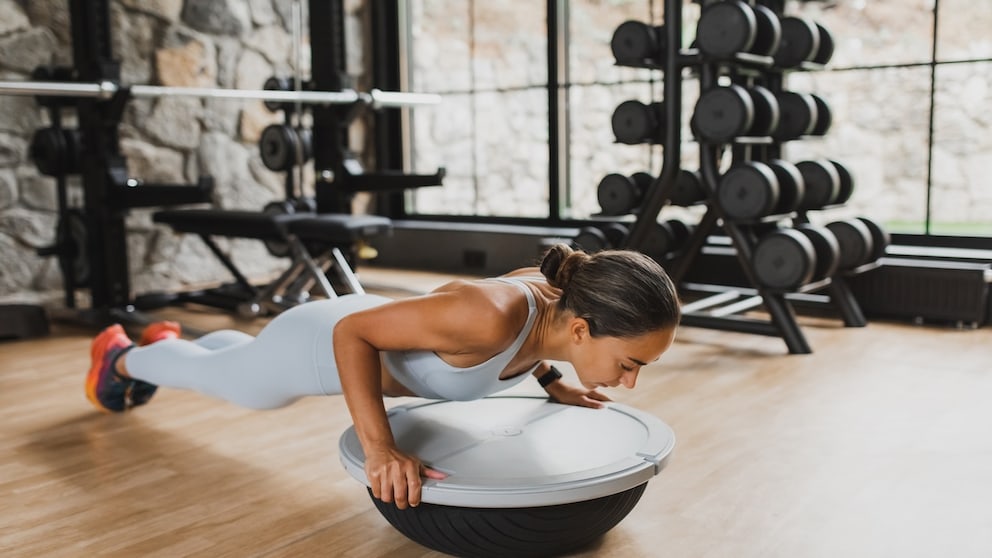April 25, 2025, 8:52 am | Read time: 5 minutes
In addition to the push-up handles, there is another alternative for advanced users to increase the difficulty of push-ups. For example, a balance board can be used to activate even more muscles. However, there are a few things to consider. How does this special piece of fitness equipment work, who is it suitable for and what do you need to bear in mind when using it?
If you have mastered classic push-ups with both hands on the floor and are no longer challenged enough, you may lose interest in this popular basic bodyweight exercise. Variety and new stimuli are needed, for example with the help of a balance board. This piece of equipment has a few peculiarities, but with the right technique it is incredibly effective. And this new challenge, in which you have to balance your body, can also be really fun! But only those who do it right can really benefit from it.
Overview
What Is a Balance Board?
Although there are different models, the structure is generally identical. A balance board consists of a fixed standing surface that rests on a movable or rather unstable base. This can be a roller, a ball or a hemisphere.
Advantages of a Balance Board
Basically, the balance board primarily trains the sense of balance and coordination, and it also strengthens the core, leg, and foot muscles. And it strengthens posture. On the other hand, our deep muscles, which often receive less attention, have to work at full speed. This is because the imbalance caused by the structure of the board must be actively compensated for in order to perform the exercise correctly. The deep muscles therefore become stronger and have to react more quickly, which also strengthens tendons and joints and reduces the risk of injury. In addition to push-ups, a balance board can also be used to perform squats, lunges or planks.1
How to Do Push-ups on the Balance Board
To assume the starting position, place both hands shoulder-width apart on the board. Your feet are stretched out behind you, and your body is stretched out in a straight line. It is also important to keep your core engaged to ensure stability. Now grasp the two outer sides of the balance board and lower your upper body down under tension, keeping your elbows close to your body and remembering to breathe in deeply. Then raise it again and exhale at the same time. During the entire movement, it is important to ensure that you do not arch your back.2
These Muscle Groups Are Activated
Due to the special feature of virtually balancing during the push-up, even more muscles are strained and challenged even more during the exercise. Compared to normal push-ups, our individual chest muscles in particular are trained, right down to the deep muscles. Shoulders, arms and core are also stimulated.
The result is clear. The increased load intensifies each repetition. Balance training therefore builds up even more strength and stability in the upper body. Incidentally, this also increases calorie consumption, which is helpful for losing weight.
To summarize, this means that due to the instability of the board, the core has to be activated more, and the abdominal, back, shoulder, and tricep muscles have to do more work. After all, our body should remain stable. Smaller, stabilizing muscles are also used. In addition, we develop our own body awareness. Push-ups on the balance board are almost perfect, especially for surfers, martial artists, or snowboarders, who need to have a particularly well-trained core.

Vary Push-up Training with a Balance Board

These Dietary Patterns Are Associated with Healthy Aging—Results from 30 Years of Research

How to Do Burpees Properly
3 Variations, 3 Levels of Difficulty
For Beginners
Beginners who want to feel their way around can do push-ups on the balance board with their knees on the floor. This variation serves as preparation for more difficult balance exercises and can also be useful for rehabilitation. By placing your knees on the floor, the exercise is not quite as intense, but the core, arms and deep muscles are still trained. Furthermore, the shoulders and wrists are not put under such extreme strain and you simply have more control over your body. As it is supported by the knees, beginners can get used to the instability of the board.
For Advanced Riders
The somewhat crisper and more complex variant has already been described above. This is the classic form in which normal push-ups are performed with both hands on the balance board. Instead of your knees, your feet are on the floor, which significantly increases the level of difficulty. You need more strength, more coordination, and increased body control and, above all, body tension to keep your balance.
For Professionals
To increase the difficulty further, you could place your feet in an elevated position. Another balance board or an exercise ball is suitable for this. This is one of the most challenging variations, as the instability is increased to the maximum. It combines the balance board for the hands and the exercise ball for the feet; both the upper and lower body must be stabilized. Chest, shoulder, arm, and core muscles are extremely challenged. The focus is primarily on the core in order to maintain balance. You also need full body control and concentration.3
Tip: Slow and controlled movements are advisable. You will probably be shaky at the beginning, but this will get better and better with increasing training.

